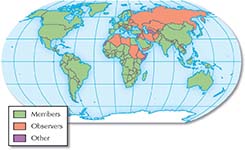CHAPTER 33: Quick Study Guide
Progress Monitoring Online
For: Self-test with vocabulary practice
Web Code: nea-2061
- World Trade Organization Members and Observers

- Major Events in the Clinton and Bush Presidencies
President Event Clinton - 1992 Signed NAFTA; sent forces into Somalia
- 1993 Signed Brady Bill; helped negotiate Declaration of Principles
- 1994 Sent troops to Haiti
- 1995 Sent forces into Bosnia as part of NATO
- 1996 Signed bill to reform welfare
- 1999 Impeached; cleared of charges
Bush - 2001 Pushed for major tax cuts; sent troops to war in Afghanistan; signed Patriot Act
- 2002 Signed No Child Left Behind Act
- 2003 Sent troops to war in Iraq
- 2004 Bush reelected
- Major Issues of American Society in the New Millennium
- Technology—Computers, satellites, and advances in agriculture raise productivity and efficiency, but challenge many workers and industries.
- Globalization—Globalization brings consumers more choices and opportunities, but can result in the loss of American jobs.
- Terrorism—After September 11, government must work to make America more secure.
- Immigration—Immigrants continue to enrich American society and fuel its economy, but their increasing numbers spark debate.
- Demographics—Federal and local governments must find ways to support older Americans, Americans on the move, and nontraditional families.
 Quick Study Timeline
Quick Study Timeline
For: Interactive timeline
Web Code: nep-2061





